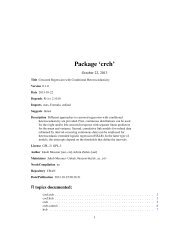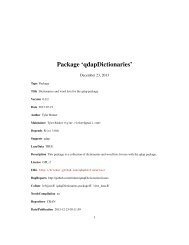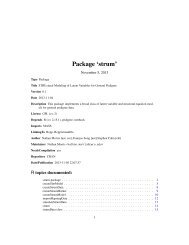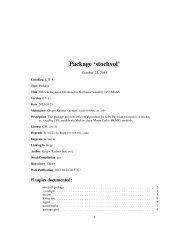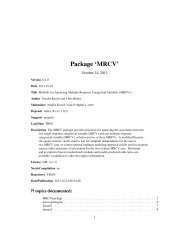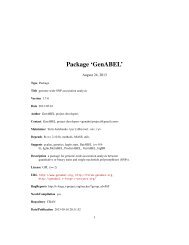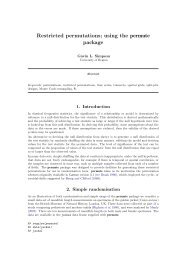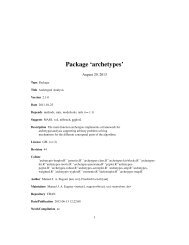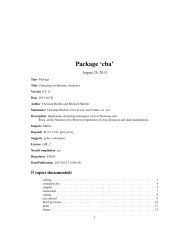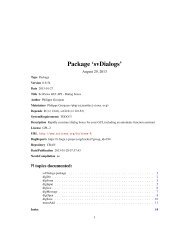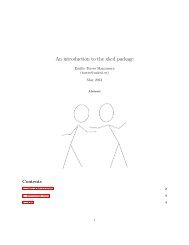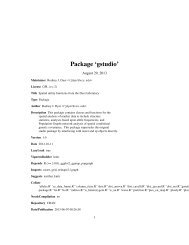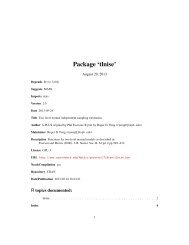Package 'GeneCycle'
Package 'GeneCycle'
Package 'GeneCycle'
Create successful ePaper yourself
Turn your PDF publications into a flip-book with our unique Google optimized e-Paper software.
Version 1.1.2<br />
Date 2012-04-15<br />
<strong>Package</strong> ‘GeneCycle’<br />
February 15, 2013<br />
Title Identification of Periodically Expressed Genes<br />
Author Miika Ahdesmaki, Konstantinos Fokianos, and Korbinian Strimmer.<br />
Maintainer Miika Ahdesmaki <br />
Depends R (>= 2.7.0), MASS, longitudinal (>= 1.1.3), fdrtool (>= 1.2.5)<br />
Suggests<br />
Description The GeneCycle package implements the approaches of Wichert<br />
et al. (2004), Ahdesmaki et al. (2005) and Ahdesmaki et al.<br />
(2007) for detecting periodically expressed genes from gene expression time series data.<br />
License GPL (>= 3)<br />
URL http://www.cs.tut.fi/~ahdesmak/robustperiodic/index.html<br />
Repository CRAN<br />
Date/Publication 2012-04-16 19:59:35<br />
NeedsCompilation no<br />
R topics documented:<br />
avgp . . . . . . . . . . . . . . . . . . . . . . . . . . . . . . . . . . . . . . . . . . . . . 2<br />
caulobacter . . . . . . . . . . . . . . . . . . . . . . . . . . . . . . . . . . . . . . . . . 3<br />
dominant.freqs . . . . . . . . . . . . . . . . . . . . . . . . . . . . . . . . . . . . . . . 4<br />
fisher.g.test . . . . . . . . . . . . . . . . . . . . . . . . . . . . . . . . . . . . . . . . . 5<br />
is.constant . . . . . . . . . . . . . . . . . . . . . . . . . . . . . . . . . . . . . . . . . . 6<br />
periodogram . . . . . . . . . . . . . . . . . . . . . . . . . . . . . . . . . . . . . . . . . 7<br />
robust.g.test . . . . . . . . . . . . . . . . . . . . . . . . . . . . . . . . . . . . . . . . . 9<br />
Index 13<br />
1
2 avgp<br />
avgp Average Periodogram for Multiple (Genetic) Time Series<br />
Description<br />
Usage<br />
avgp calculates and plots the average periodogram as described in Wichert, Fokianos and Strimmer<br />
(2004).<br />
avgp(x, title = deparse(substitute(x)), plot = TRUE, angular = FALSE, ...)<br />
Arguments<br />
Details<br />
Value<br />
x multiple (genetic) time series data. Each column of this matrix corresponds to<br />
a separate variable/time series<br />
title name of the data set (default is the name of the data object)<br />
plot plot the average periodogram?<br />
angular convert frequencies to angular frequencies?<br />
... arguments passed to plot and to periodogram<br />
The average periodogram is simply the frequency-wise average of the spectral density (as estimated<br />
by the Fourier transform) over all times series. To calculate the average periodogram the function<br />
periodogram is used. See Wichert, Fokianos and Strimmer (2004) for more details.<br />
A list object with the following components:<br />
freq A vector with the discrete Fourier frequencies (see periodogram). If the option<br />
angular=TRUE then the output are angular frequencies (2*pi*f).<br />
avg.spec A vector with the average power spectral density at each frequency.<br />
title Name of the data set underlying the average periodogram.<br />
The result is returned invisibly if plot is true.<br />
Author(s)<br />
Konstantinos Fokianos (http://www.ucy.ac.cy/~fokianos/) and Korbinian Strimmer (http:<br />
//strimmerlab.org).<br />
References<br />
Wichert, S., Fokianos, K., and Strimmer, K. (2004). Identifying periodically expressed transcripts<br />
in microarray time series data. Bioinformatics 20:5-20.
caulobacter 3<br />
See Also<br />
periodogram, spectrum.<br />
Examples<br />
# load GeneCycle library<br />
library("GeneCycle")<br />
# load data set<br />
data(caulobacter)<br />
# how many samples and how many genes?<br />
dim(caulobacter)<br />
# average periodogram<br />
avgp.caulobacter
4 dominant.freqs<br />
Examples<br />
# load GeneCycle library<br />
library("GeneCycle")<br />
# load data set<br />
data(caulobacter)<br />
is.longitudinal(caulobacter)<br />
# how many samples and how many genes?<br />
dim(caulobacter)<br />
summary(caulobacter)<br />
get.time.repeats(caulobacter)<br />
# plot first nine time series<br />
plot(caulobacter, 1:9)<br />
dominant.freqs Dominant Frequencies in Multiple (Genetic) Time Series<br />
Description<br />
Usage<br />
dominant.freqs returns the m dominant frequencies (highest peaks) in each of the periodogram<br />
computed for the individual time series.<br />
dominant.freqs(x, m=1, ...)<br />
Arguments<br />
Value<br />
x multivariate (genetic) time series (each column of this matrix corresponds to a<br />
separate variable/time series), or a vector with a single time series<br />
m number of dominant frequences<br />
... arguments passed to periodogram<br />
A matrix (or vector, if only 1 time series is considered) with the dominant frequencies. In a matrix,<br />
each column corresponds to one time series.<br />
Author(s)<br />
Konstantinos Fokianos (http://www.ucy.ac.cy/~fokianos/) and Korbinian Strimmer (http:<br />
//strimmerlab.org).<br />
See Also<br />
periodogram, spectrum.
fisher.g.test 5<br />
Examples<br />
# load GeneCycle library<br />
library("GeneCycle")<br />
# load data set<br />
data(caulobacter)<br />
# how many samples and how many genes?<br />
dim(caulobacter)<br />
# first three dominant frequencies for each gene<br />
dominant.freqs(caulobacter, 3)<br />
# first four dominant frequencies for gene no. 1000<br />
dominant.freqs(caulobacter[,1000], 4)<br />
fisher.g.test Fisher’s Exact g Test for Multiple (Genetic) Time Series<br />
Description<br />
Usage<br />
fisher.g.test calculates the p-value(s) according to Fisher’s exact g test for one or more time<br />
series. This test is useful to detect hidden periodicities of unknown frequency in a data set. For an<br />
application to microarray data see Wichert, Fokianos, and Strimmer (2004).<br />
fisher.g.test(x, ...)<br />
Arguments<br />
Details<br />
Value<br />
x vector or matrix with time series data (one time series per column).<br />
... arguments passed to periodogram<br />
Fisher (1929) devised an exact procedure to test the null hypothesis of Gaussian white noise against<br />
the alternative of an added deterministic periodic component of unspecified frequency. The basic<br />
idea behind the test is to reject the null hypothesis if the periodogram contains a value significantly<br />
larger than the average value (cf. Brockwell and Davis, 1991). This test is useful in the context<br />
of microarray genetic time series analysis as a gene selection method - see Wichert, Fokianos and<br />
Strimmer (2004) for more details. Note that in the special case of a constant time series the p-value<br />
returned by fisher.g.test is exactly 1 (i.e. the null hypothesis is not rejected).<br />
A vector of p-values (one for each time series). Multiple testing may then be done using the the<br />
false discover rate approach (function fdrtool).
6 is.constant<br />
Author(s)<br />
Konstantinos Fokianos (http://www.ucy.ac.cy/~fokianos/) and Korbinian Strimmer (http:<br />
//strimmerlab.org).<br />
References<br />
Fisher, R.A. (1929). Tests of significance in harmonic analysis. Proc. Roy. Soc. A, 125, 54–59.<br />
Brockwell, P.J., and Davis, R.A. (1991). Time Series: Theory and Methods (2nd ed). Springer<br />
Verlag. (the g-test is discussed in section 10.2).<br />
Wichert, S., Fokianos, K., and Strimmer, K. (2004). Identifying periodically expressed transcripts<br />
in microarray time series data. Bioinformatics 20:5-20.<br />
See Also<br />
fdrtool.<br />
Examples<br />
# load GeneCycle library<br />
library("GeneCycle")<br />
# load data set<br />
data(caulobacter)<br />
# how many samples and and how many genes?<br />
dim(caulobacter)<br />
# p-values from Fisher’s g test<br />
pval.caulobacter
periodogram 7<br />
Usage<br />
is.constant(x)<br />
Arguments<br />
Value<br />
x vector or matrix with time series data (one time series per column)<br />
A vector with a boolean statement (TRUE or FALSE) for each time series.<br />
Author(s)<br />
Korbinian Strimmer (http://strimmerlab.org).<br />
Examples<br />
# load GeneCycle library<br />
library("GeneCycle")<br />
# load data set<br />
data(caulobacter)<br />
# any constant genes?<br />
sum(is.constant(caulobacter))<br />
# but here:<br />
series.1
8 periodogram<br />
Arguments<br />
Value<br />
x vector or matrix containing the time series data (one time series per column)<br />
method a string that specifies which method should be used to compute the spectral<br />
density: "builtin" employs the function spectrum with the options taper=0,<br />
plot=FALSE, fast=FALSE, detrend=FALSE, and demean=TRUE; "clone" employs<br />
directly the Fourier transform function fft (with sames results as "builtin");<br />
and "smooth" uses the function spectrum with options as above plus span=3.<br />
A list object with the following components:<br />
spec A vector or matrix with the estimated power spectral densities (one column per<br />
time series).<br />
freq A vector with frequencies f ranging from 0 to fc (if the sampling rate frequency(x))<br />
equals 1 then fc = 0.5). Angular frequencies may be obtained by multiplication<br />
with 2*pi (i.e. omega = 2*pi*f).<br />
Author(s)<br />
Konstantinos Fokianos (http://www.ucy.ac.cy/~fokianos/) and Korbinian Strimmer (http:<br />
//strimmerlab.org).<br />
See Also<br />
spectrum, avgp, fisher.g.test.<br />
Examples<br />
# load GeneCycle library<br />
library("GeneCycle")<br />
# load data set<br />
data(caulobacter)<br />
# how many genes and how many samples?<br />
dim(caulobacter)<br />
# periodograms of the first 10 genes<br />
periodogram(caulobacter[,1:10])
obust.g.test 9<br />
robust.g.test Robust g Test for Multiple (Genetic) Time Series<br />
Description<br />
Usage<br />
robust.g.test calculates the p-value(s) for a robust nonparametric version of Fisher’s g-test<br />
(1929). Details of this approach are described in Ahdesmaki et al. (2005), along with an extensive<br />
discussion of its application to gene expression data. From GeneCycle 1.1.0 on the robust<br />
regression based method published in Ahdesmaki et al. (2007) is also implemented (using Tukey’s<br />
biweight based M-estimation/regression.)<br />
robust.spectrum computes a robust rank-based estimate of the periodogram/correlogram - see<br />
Ahdesmaki et al. (2005) for details. Alternatively it can also be used (since GeneCycle 1.1.0)<br />
for evaluating the robust regression based spectral estimates, suitable for processing non-uniformly<br />
sampled data (unknown periodicity time: return spectral estimates, known periodicity time: return<br />
p-values).<br />
robust.g.test(y, index, perm = FALSE, x, noOfPermutations = 300,<br />
algorithm=c("rank", "regression"), t)<br />
robust.spectrum(x, algorithm = c("rank", "regression"), t,<br />
periodicity.time = FALSE, noOfPermutations = 300)<br />
Arguments<br />
y the matrix consisting of the spectral estimates as column vectors<br />
index an index to the spectral estimates (RANK BASED APPROACH ONLY; for<br />
specifying a periodicity time in the regression approach, see the parameter periodicity.time)<br />
that is to be used in the testing for periodicity. If index is missing<br />
for the rank based approach, the maximum component of the spectral estimate<br />
is used in testing (regardless of the frequency of this maximum)<br />
periodicity.time<br />
time (same units as in vector t) of period where periodicity will be detected<br />
(ROBUST REGRESSION BASED APPROACH ONLY) that is to be used in<br />
the search for periodicity. If periodicity.time is not given for the regression<br />
based approach, the whole spectrum is evaluated (more time consuming) and<br />
the maximum periodogram ordinate will be investigated<br />
perm if perm is FALSE, a simulated distribution for the g-statistic is used (applies to<br />
the rank based approach only). If per perm is TRUE, permutation tests are used<br />
to find the distribution of the g-statistic for each time series separately. With<br />
the regression based approach (Ahdesmaki et al. 2007) permutation tests will<br />
always be used<br />
x a matrix consisting of the time series as column vectors. In robust.g.test<br />
only needed if permutation tests are used<br />
noOfPermutations<br />
number of permutations that are used for each time series (default = 300)
10 robust.g.test<br />
Details<br />
Value<br />
algorithm rank corresponds to the rank based approach (Ahdesmaki et al. 2005) and<br />
regression for the regression based approach (Ahdesmaki et al. 2007), which<br />
is more suitable for time series with non-uniform sampling (default = rank)<br />
t sampling time vector (only for the regression based approach)<br />
Application of robust.g.test can be very computer intensive, especially the production of the<br />
distribution of the test statistics may take a lot of time. Therefore, this distribution (dependening<br />
on the length of the time series) is stored in an external file to avoid recomputation (see example<br />
below). When applying permutation tests no external file is used but the computation time will<br />
always be high.<br />
For the general idea behind the Fisher’s g test also see fisher.g.test which implements an analytic<br />
approach for g-testing. This is faster but not robust and also assumes Gaussian noise.<br />
Note that when using the regression based approach there will regularly be warnings about the<br />
non-convergence of the regression (iteration limit default at 20 cycles in rlm).<br />
robust.g.test returns a list of p-values. robust.spectrum returns a matrix where the column<br />
vectors correspond to the spectra corresponding to each time series. As an exception, if the robust<br />
regression based approach (Ahdesmaki et al. 2007) is used with a known periodicity time, the<br />
function robust.spectrum returns p-values (computation will take a lot of time depending on how<br />
many permutations are used per time series and time series length).<br />
Author(s)<br />
Miika Ahdesmaki ().<br />
References<br />
Fisher, R.A. (1929). Tests of significance in harmonic analysis. Proc. Roy. Soc. A, 125, 54–59.<br />
Ahdesmaki, M., Lahdesmaki, H., Pearson, R., Huttunen, H., and Yli-Harja O. (2005). BMC Bioinformatics<br />
6:117. http://www.biomedcentral.com/1471-2105/6/117<br />
Ahdesmaki, M., Lahdesmaki, H., Gracey, A., Shmulevich, I., and Yli-Harja O. (2007). BMC Bioinformatics<br />
8:233. http://www.biomedcentral.com/1471-2105/8/233<br />
See Also<br />
fdrtool, fisher.g.test.<br />
Examples<br />
## Not run:<br />
# load GeneCycle library<br />
library("GeneCycle")<br />
# load data set
obust.g.test 11<br />
data(caulobacter)<br />
# how many samples and and how many genes?<br />
dim(caulobacter)<br />
# robust, rank-based spectral estimator applied to first 5 genes<br />
spe5 = robust.spectrum(caulobacter[,1:5])<br />
# g statistics can be computed from the spectrum (internal use mostly<br />
# but can be checked here)<br />
## g.statistic(spe5)<br />
# robust p-values, use Monte Carlo simulation (not permutation tests)<br />
# to estimate the null hypothesis distribution<br />
pval = robust.g.test(spe5) # generates a file with the name "g_pop_length_11.txt"<br />
pval = robust.g.test(spe5) # second call: much faster..<br />
pval<br />
# robust p-values, now look at index 4 (index can be anything from 1<br />
# (DC-level) to N (length of the time series and highest frequency))<br />
pval = robust.g.test(spe5, 4) # generates a file<br />
pval = robust.g.test(spe5, 4) # second call: much faster..<br />
pval<br />
# delete the external files<br />
unlink("g_pop_length_11.txt")<br />
unlink("g_pop_length_11indexed.txt")<br />
#<br />
# Next let us see how the robust regression based approach can be<br />
# applied (Ahdesmaki et al. 2007)<br />
# First: Unknown frequencies<br />
t=c(0,15,30,45,60,75,90,105,120,135,150)<br />
y = robust.spectrum(x=caulobacter[,1:5],algorithm="regression", t=t)<br />
pvals = robust.g.test(y = y, perm=TRUE, x=caulobacter[,1:5],<br />
noOfPermutations = 50, algorithm = "regression", t=t)<br />
pvals<br />
#<br />
# The following example illustrates how to use the regression based<br />
# method if we have prior knowledge about the frequency/period time<br />
# of periodicity<br />
t = 0:9 # time indices<br />
t = t + runif(10)-0.5 # make time indices non-uniform<br />
A = 0.5 * matrix(rnorm(50),10,5) # create random time series (no outliers)<br />
A[,5]=A[,5]+matrix(sin(0.5*pi*t),10,1) # superimpose a sinusoidal<br />
periodicity.time=4 # where to look for periodicity<br />
# note that now the function robust.spectrum returns the p-values (in
12 robust.g.test<br />
# all other cases it will return spectral estimates):<br />
pvals=robust.spectrum(x=A,algorithm="regression",<br />
t=t,periodicity.time=periodicity.time, noOfPermutations=50)<br />
pvals # 5th p-value is smallish, as expected<br />
## End(Not run)
Index<br />
∗Topic datasets<br />
caulobacter, 3<br />
∗Topic htest<br />
fisher.g.test, 5<br />
robust.g.test, 9<br />
∗Topic ts<br />
avgp, 2<br />
dominant.freqs, 4<br />
is.constant, 6<br />
periodogram, 7<br />
avgp, 2, 7, 8<br />
avpg (avgp), 2<br />
caulobacter, 3<br />
dominant.freqs, 4<br />
fdrtool, 5, 6, 10<br />
fft, 8<br />
fisher.g.test, 5, 7, 8, 10<br />
frequency, 7, 8<br />
is.constant, 6<br />
longitudinal, 3<br />
periodogram, 2–5, 7<br />
plot, 2<br />
rlm, 10<br />
robust.g.test, 9<br />
robust.spectrum (robust.g.test), 9<br />
spectrum, 3, 4, 7, 8<br />
13



